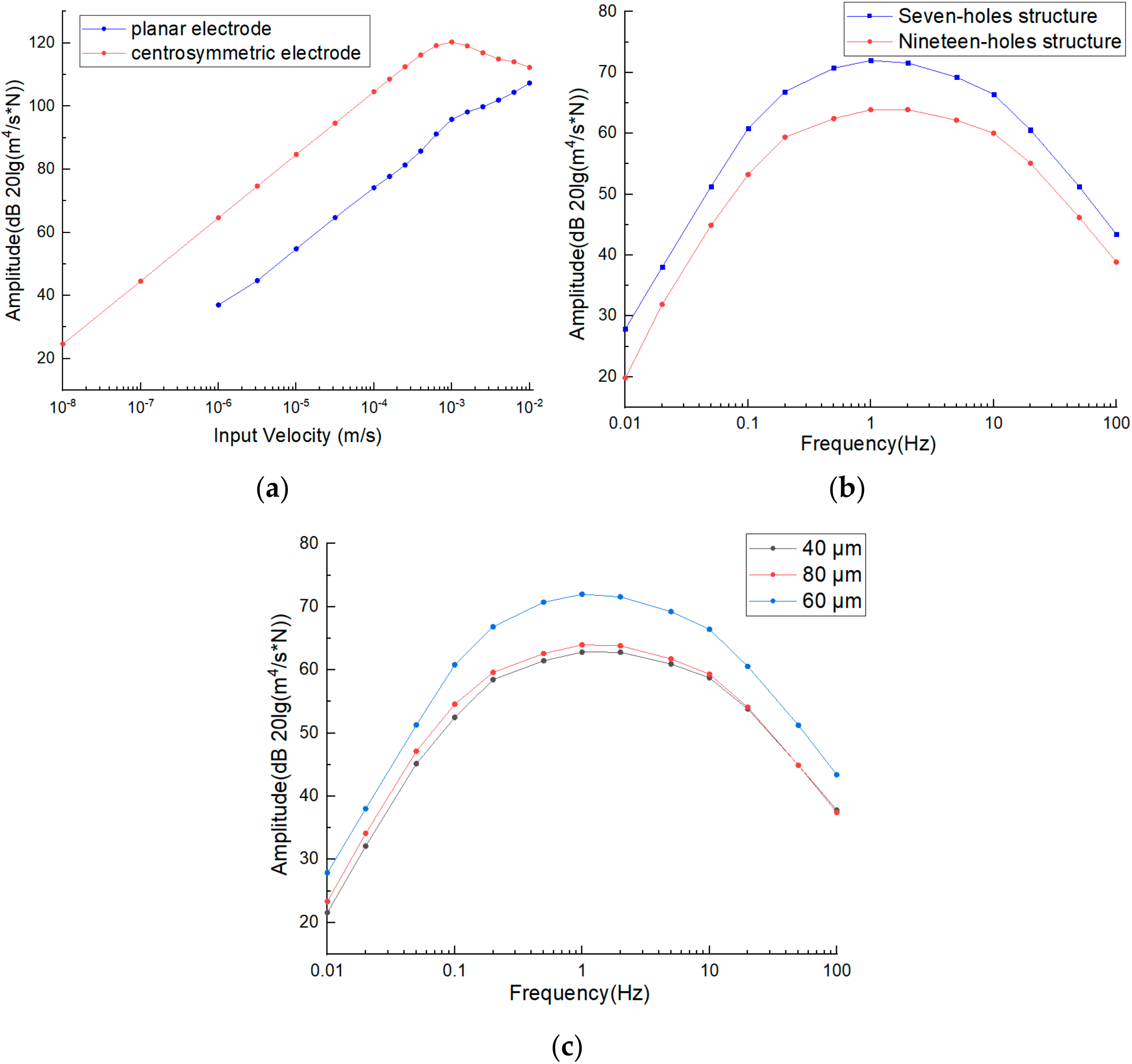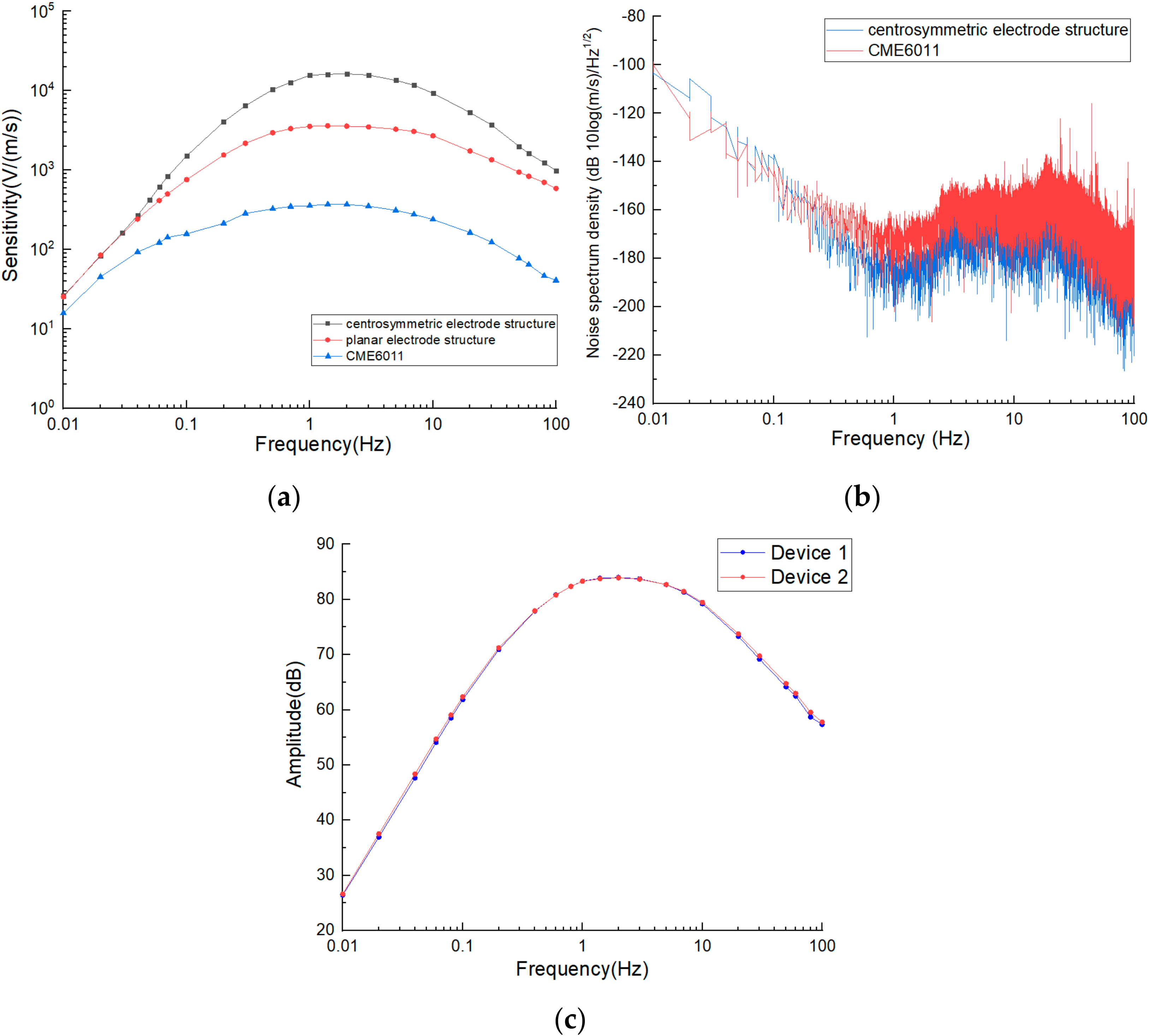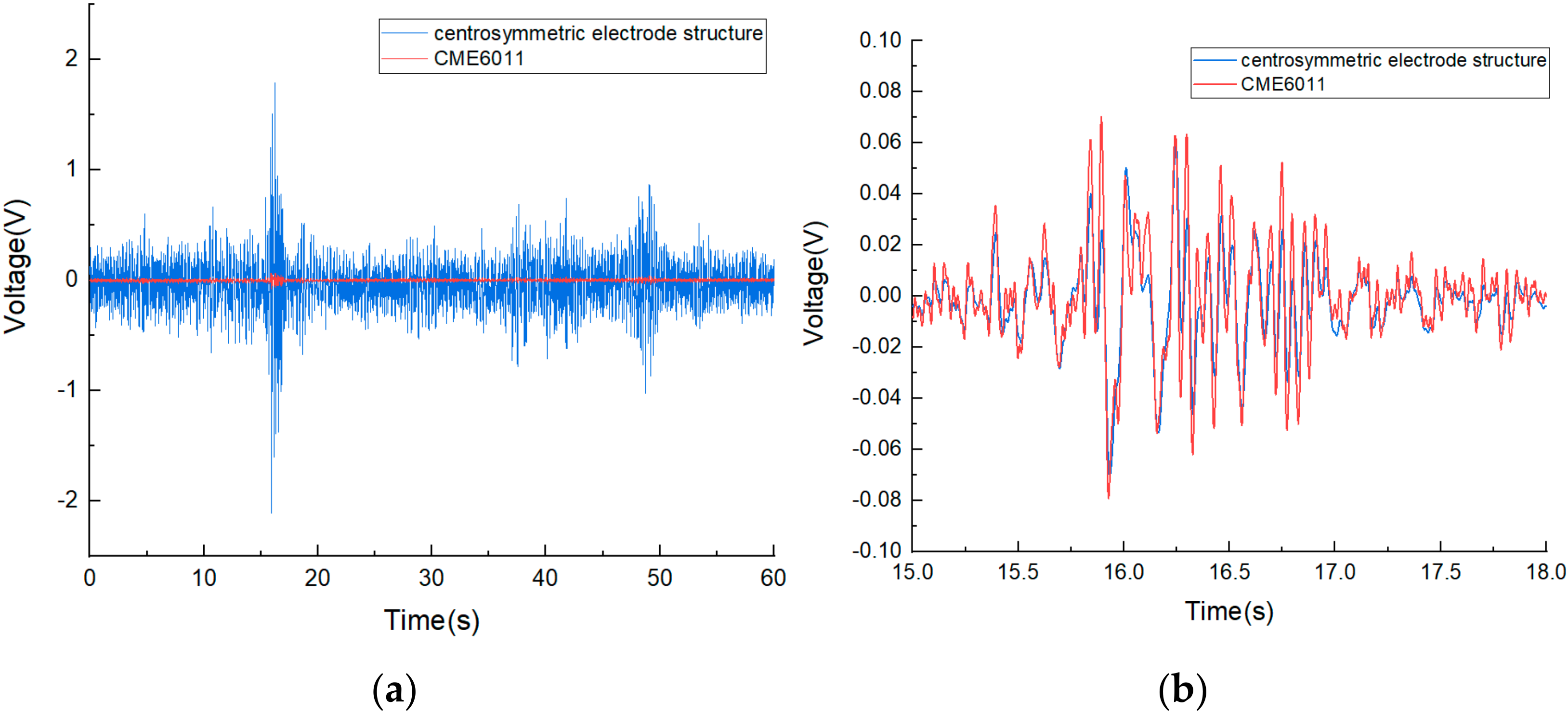A MEMS Electrochemical Seismometer Based on the Integrated Structure of Centrosymmetric Four Electrodes
Abstract
:1. Introduction
2. Structure and Working Principle
3. Simulation
4. Fabrication
5. Result
6. Conclusions
Author Contributions
Funding
Institutional Review Board Statement
Informed Consent Statement
Data Availability Statement
Conflicts of Interest
References
- Havskov, J.; Alguacil, G. Instrumentation in Earthquake Seismology; Springer Netherlands: Dordrecht, The Netherlands, 2010; pp. 1–5. [Google Scholar]
- Niu, F.; Silver, P.G.; Daley, T.M.; Cheng, X.; Majer, E.L. Preseismic velocity changes observed from active source monitoring at the parkfield SAFOD drill site. Nature 2008, 454, 204–208. [Google Scholar] [CrossRef] [PubMed]
- Zeng, R.; Lin, J.; Zhao, Y.J. Development situation of seismic sensorss and its application in seismic array observation. Prog. Geophys. 2014, 29, 2106–2112. [Google Scholar]
- Wang, Q.; Liu, H.F.; Liang, C. High-precision MEMS inertial sensors for geophysical applications. Navig. Control. 2018, 17, 4–12. [Google Scholar]
- Zhang, G.H.; Hu, S.Y. Dynamic characteristics of moving-coil geophone with large damping. Int. J. Appl. Electromagn. Mech. 2010, 33, 565–571. [Google Scholar] [CrossRef]
- Wang, J.B.; Gong, L.M.; Chen, D.Y.; He, W.T.; Wang, P. Mems based electrochemical seismic sensors with planar electrodes. Guangxue Jingmi Gongcheng/Opt. Precis. Eng. 2015, 23, 769–775. [Google Scholar]
- Zhou, X.; Liang, L. The structure design and emulation of characteristics of fiber bragg grating geophone. Earthq. Eng. Eng. Vib. 2005, 25, 177–180. [Google Scholar]
- Liang, T.C.; Lin, Y.L. Fiber optic sensor for detection of ground vibrations. In Proceedings of the Third Asia Pacific Optical Sensors Conference, International Society for Optics and Photonics, Sydney, Australia, 31 January 2012; Volume 8351, p. 835109. [Google Scholar]
- Rudolf, F.; Jornod, A.; Bergqvist, J.; Leuthold, H. Precision accelerometers with μg resolution. Sens. Actuators A Phys. 1990, 21, 297–302. [Google Scholar] [CrossRef]
- Krishtop, V.G.; Agafonov, V.M.; Bugaev, A.S. Technological principles of motion parameter transducers based on mass and charge transport in electrochemical microsystems. Russ. J. Electrochem. 2012, 48, 746–755. [Google Scholar] [CrossRef]
- Levinzon, F.A. Ultra-low-noise seismic piezoelectric accelerometer with integral FET amplifier. IEEE Sens. J. 2012, 12, 2262–2268. [Google Scholar] [CrossRef]
- Huang, H.; Agafonov, V.; Yu, H. Molecular electric transducers as motion sensors: A review. Sensors 2013, 13, 4581–4597. [Google Scholar] [CrossRef] [PubMed] [Green Version]
- Kozlov, V.A.; Terent’Ev, D.A. Frequency characteristics of a spatially-confined electrochemical cell under conditions of convective diffusion. Russ. J. Electrochem. 2002, 38, 992–999. [Google Scholar] [CrossRef]
- Liang, M.B.; Huang, H.; Agafonov, V.; Tang, R. Molecular electronic transducer based planetary seismometer with new fabrication process. In Proceedings of the IEEE 29th International Conference on Micro Electro Mechanical Systems (MEMS), Shanghai, China, 24–28 January 2016. [Google Scholar]
- He, W.T.; Chen, D.Y.; Wang, J.B.; Zhang, Z.Y. Mems based broadband electrochemical seismometer. Guangxue Jingmi Gongcheng/Opt. Precis. Eng. 2015, 23, 444–451. [Google Scholar]
- Deng, T.; Chen, D.Y.; Chen, J.; Sun, Z.Y.; Li, G.L.; Wang, J.B. Microelectromechanical systems based electrochemical seismic sensors with insulating spacers integrated electrodes for planetary exploration. IEEE Sens. J. 2016, 16, 650–653. [Google Scholar] [CrossRef]
- Deng, T.; Sun, Z.Y.; Li, G.L.; Chen, J.; Chen, D.Y.; Wang, J.B. Microelectromechanical system-based electrochemical seismic sensors with an anode and a cathode integrated on one chip. J. Micromech. Microeng. 2016, 27, 025004. [Google Scholar] [CrossRef]
- Xu, C.; Wang, J.B.; Chen, D.Y.; Chen, J.; Zheng, X.C. The electrochemical seismometer based on fine-tune sensing electrodes for undersea exploration. IEEE Sens. J. 2020, 20, 8194–8202. [Google Scholar] [CrossRef]
- Xu, C.; Wang, J.B.; Chen, D.Y.; Chen, J.; Liu, B.W.; Liang, T.; Qi, W.J.; She, X. The MEMS-Based Electrochemical Seismic Sensor With Integrated Sensitive Electrodes by Adopting Anodic Bonding Technology. IEEE Sens. J. 2021, 21, 19833–19839. [Google Scholar] [CrossRef]
- Zheng, X.C.; Chen, D.Y.; Wang, J.B.; Chen, J.; Xu, C.; Qi, W.J.; Liu, B.Y. Microelectromechanical system-based electrochemical seismometers with two pairs of electrodes integrated on one chip. Sensors 2019, 19, 3953. [Google Scholar] [CrossRef] [PubMed] [Green Version]
- ChenJim, X.; LoboN, D.V. Toward interactive—rate simulation of fluids with moving obstacles using Navier Stokes equations Graph. Models Image Process. 1995, 57, 107–116. [Google Scholar]
- García-Hernández, M.T.; Castilla, J.; González-Fernández, C.F.; Horno, J. Application of the network method to simulation of a square scheme with butler-volmer charge transfer. J. Electroanal. Chem. 1997, 424, 207–212. [Google Scholar] [CrossRef]







Publisher’s Note: MDPI stays neutral with regard to jurisdictional claims in published maps and institutional affiliations. |
© 2022 by the authors. Licensee MDPI, Basel, Switzerland. This article is an open access article distributed under the terms and conditions of the Creative Commons Attribution (CC BY) license (https://creativecommons.org/licenses/by/4.0/).
Share and Cite
Duan, Y.; Zhong, A.; Lu, Y.; Chen, J.; Chen, D.; Wang, J. A MEMS Electrochemical Seismometer Based on the Integrated Structure of Centrosymmetric Four Electrodes. Micromachines 2022, 13, 354. https://doi.org/10.3390/mi13030354
Duan Y, Zhong A, Lu Y, Chen J, Chen D, Wang J. A MEMS Electrochemical Seismometer Based on the Integrated Structure of Centrosymmetric Four Electrodes. Micromachines. 2022; 13(3):354. https://doi.org/10.3390/mi13030354
Chicago/Turabian StyleDuan, Yumo, Anxiang Zhong, Yulan Lu, Jian Chen, Deyong Chen, and Junbo Wang. 2022. "A MEMS Electrochemical Seismometer Based on the Integrated Structure of Centrosymmetric Four Electrodes" Micromachines 13, no. 3: 354. https://doi.org/10.3390/mi13030354
APA StyleDuan, Y., Zhong, A., Lu, Y., Chen, J., Chen, D., & Wang, J. (2022). A MEMS Electrochemical Seismometer Based on the Integrated Structure of Centrosymmetric Four Electrodes. Micromachines, 13(3), 354. https://doi.org/10.3390/mi13030354







